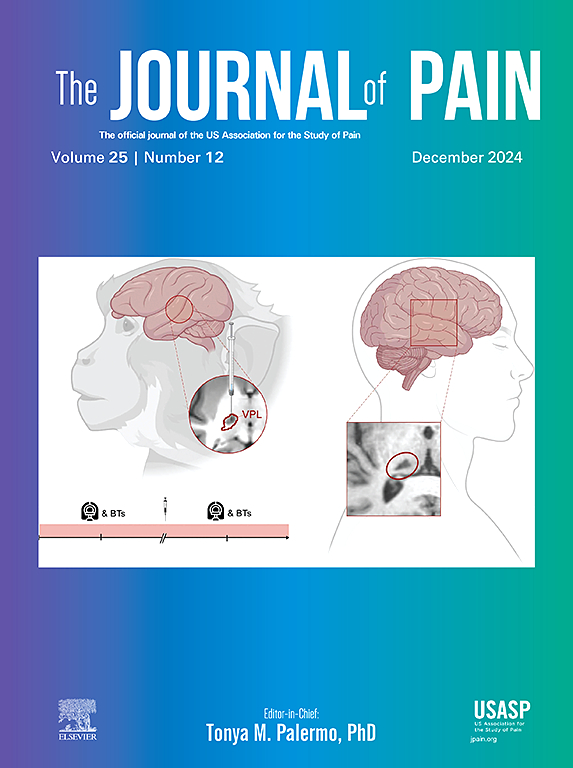儿童青少年伤害感受性、神经性和伤害性的鉴别方法:心理测量特性和可行性的系统综述。
IF 4
2区 医学
Q1 CLINICAL NEUROLOGY
引用次数: 0
摘要
本系统综述的目的是识别和批判性分析可用于将儿童和青少年疼痛分类为伤害性疼痛、神经性疼痛和伤害性疼痛的工具。如果研究(i)包括平均年龄为0-24岁的儿童和青少年,(ii)检查了将疼痛分类为伤害性、神经性或伤害性的评估工具,以及(iii)检查了这些工具的心理测量特性,则纳入研究。2024年3月,在5个在线数据库中进行了敏感搜索。两位作者使用基于共识的健康测量工具选择标准(COSMIN)对符合条件的研究进行了偏倚风险和质量评估。这项搜索产生了针对11种工具的26项研究。没有评估工具有证据证明所有推荐的九种心理测量特性。定量感觉测试是一种用于识别致害性和神经性疼痛体征和症状的工具,是研究最多的工具,在结构效度、标准效度和信度方面具有中等证据。三个自我报告的问卷,自我报告的利兹神经性症状和体征评估(S-LANSS),中枢致敏性量表(CSI)和PainDETECT,具有中等程度的结构效度证据,并有望作为识别可能的神经性或伤害性疼痛的初步工具。然而,当单独使用时,它们的特异性较低。所有的评估方法都将受益于儿童和青少年进一步的心理测量评估和验证。观点:本系统综述强调了儿童和青少年疼痛评估工具的有限有效性。虽然定量感觉测试和自我报告问卷在识别疼痛机制方面显示出希望,但它们的适用性仍然不确定。进一步的心理测量验证对于改善年轻人群的疼痛评估和指导个性化治疗至关重要。本文章由计算机程序翻译,如有差异,请以英文原文为准。
Methods to discriminate between nociceptive, neuropathic and nociplastic in children & adolescents: A systematic review of psychometric properties and feasibility
The aim of this systematic review was to identify and critically analyse the tools available for categorising pain as nociceptive, neuropathic and nociplastic pain in children and adolescents. Studies were included if they (i) included children and adolescents with a mean age of 0–24 years old, (ii) examined assessment tools that categorise pain as nociceptive, neuropathic or nociplastic, and (iii) examined the psychometric properties of the tools. Sensitive searches were conducted in five online databases in March 2024. Eligible studies were assessed for risk of bias and quality by two authors using COnsensus-based Standards for the selection of health Measurement INstruments (COSMIN) criteria. The search yielded 26 studies for 11 tools. No assessment tool had evidence for all nine recommended psychometric properties. Quantitative Sensory Testing, a tool used to identify signs and symptoms of nociplastic and neuropathic pain, was the most studied tool and had moderate evidence for construct validity, criterion validity and reliability. Three self-reported questionnaires, the Self-reported Leeds Assessment of Neuropathic Symptoms and Signs (S-LANSS), Central Sensitisation Inventory (CSI) and PainDETECT, had moderate evidence for construct validity and show promise as preliminary tools to identify possible neuropathic or nociplastic pain. However, they had low specificity when used in isolation. All assessment methods would benefit from further psychometric evaluation and validation in children and adolescents.
Perspective
This systematic review highlights the limited validation of pain assessment tools for children and adolescents. While Quantitative Sensory Testing and self-reported questionnaires show promise in identifying pain mechanisms, their applicability remains uncertain. Further psychometric validation is crucial to improve pain assessment and guide personalized treatment in young populations.
求助全文
通过发布文献求助,成功后即可免费获取论文全文。
去求助
来源期刊

Journal of Pain
医学-临床神经学
CiteScore
6.30
自引率
7.50%
发文量
441
审稿时长
42 days
期刊介绍:
The Journal of Pain publishes original articles related to all aspects of pain, including clinical and basic research, patient care, education, and health policy. Articles selected for publication in the Journal are most commonly reports of original clinical research or reports of original basic research. In addition, invited critical reviews, including meta analyses of drugs for pain management, invited commentaries on reviews, and exceptional case studies are published in the Journal. The mission of the Journal is to improve the care of patients in pain by providing a forum for clinical researchers, basic scientists, clinicians, and other health professionals to publish original research.
 求助内容:
求助内容: 应助结果提醒方式:
应助结果提醒方式:


